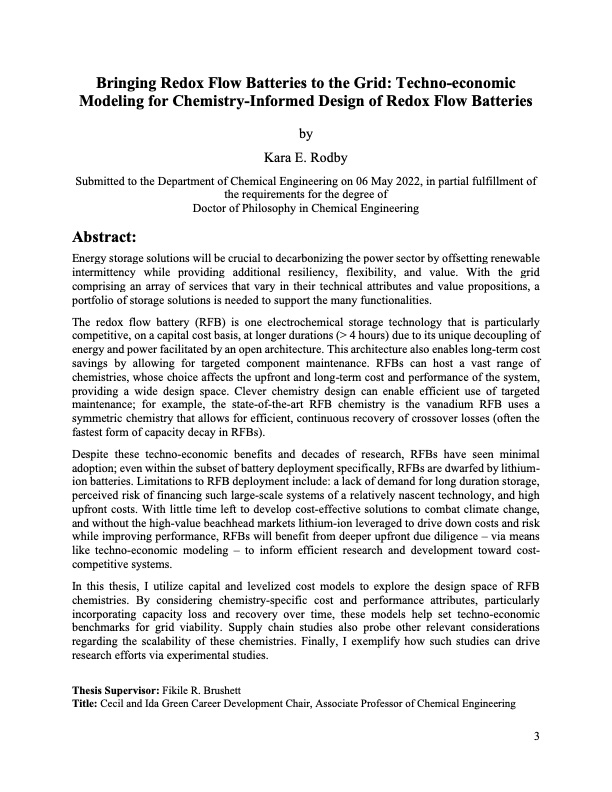
PDF Publication Title:
Text from PDF Page: 003
Bringing Redox Flow Batteries to the Grid: Techno-economic Modeling for Chemistry-Informed Design of Redox Flow Batteries by Kara E. Rodby Submitted to the Department of Chemical Engineering on 06 May 2022, in partial fulfillment of the requirements for the degree of Doctor of Philosophy in Chemical Engineering Abstract: The redox flow battery (RFB) is one electrochemical storage technology that is particularly competitive, on a capital cost basis, at longer durations (> 4 hours) due to its unique decoupling of energy and power facilitated by an open architecture. This architecture also enables long-term cost savings by allowing for targeted component maintenance. RFBs can host a vast range of chemistries, whose choice affects the upfront and long-term cost and performance of the system, providing a wide design space. Clever chemistry design can enable efficient use of targeted maintenance; for example, the state-of-the-art RFB chemistry is the vanadium RFB uses a symmetric chemistry that allows for efficient, continuous recovery of crossover losses (often the fastest form of capacity decay in RFBs). Despite these techno-economic benefits and decades of research, RFBs have seen minimal adoption; even within the subset of battery deployment specifically, RFBs are dwarfed by lithium- ion batteries. Limitations to RFB deployment include: a lack of demand for long duration storage, perceived risk of financing such large-scale systems of a relatively nascent technology, and high upfront costs. With little time left to develop cost-effective solutions to combat climate change, and without the high-value beachhead markets lithium-ion leveraged to drive down costs and risk while improving performance, RFBs will benefit from deeper upfront due diligence – via means like techno-economic modeling – to inform efficient research and development toward cost- competitive systems. In this thesis, I utilize capital and levelized cost models to explore the design space of RFB chemistries. By considering chemistry-specific cost and performance attributes, particularly incorporating capacity loss and recovery over time, these models help set techno-economic benchmarks for grid viability. Supply chain studies also probe other relevant considerations regarding the scalability of these chemistries. Finally, I exemplify how such studies can drive research efforts via experimental studies. Thesis Supervisor: Fikile R. Brushett Title: Cecil and Ida Green Career Development Chair, Associate Professor of Chemical Engineering Energy storage solutions will be crucial to decarbonizing the power sector by offsetting renewable intermittency while providing additional resiliency, flexibility, and value. With the grid comprising an array of services that vary in their technical attributes and value propositions, a portfolio of storage solutions is needed to support the many functionalities. 3PDF Image | Bringing Redox Flow Batteries to the Grid

PDF Search Title:
Bringing Redox Flow Batteries to the GridOriginal File Name Searched:
Rodby-krodby-phd-chemE-2022-thesis.pdfDIY PDF Search: Google It | Yahoo | Bing
Salgenx Redox Flow Battery Technology: Salt water flow battery technology with low cost and great energy density that can be used for power storage and thermal storage. Let us de-risk your production using our license. Our aqueous flow battery is less cost than Tesla Megapack and available faster. Redox flow battery. No membrane needed like with Vanadium, or Bromine. Salgenx flow battery
| CONTACT TEL: 608-238-6001 Email: greg@salgenx.com | RSS | AMP |